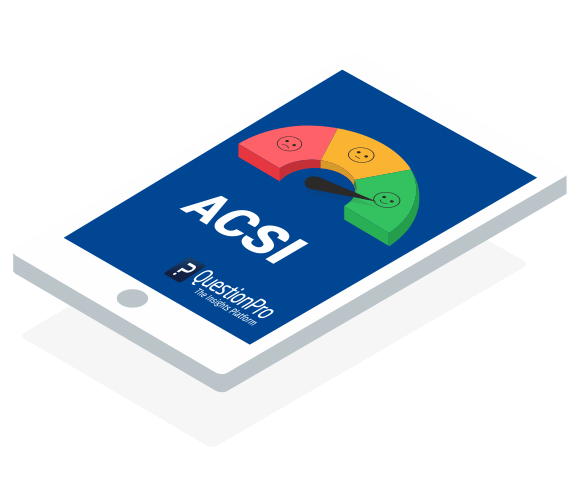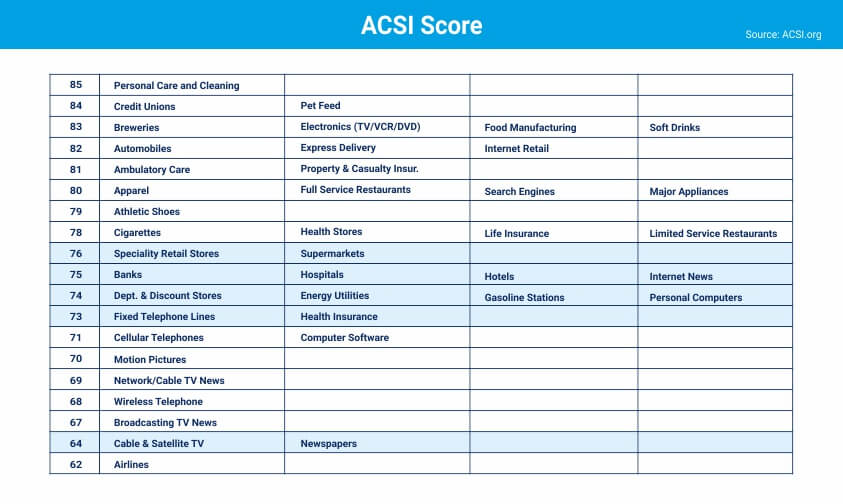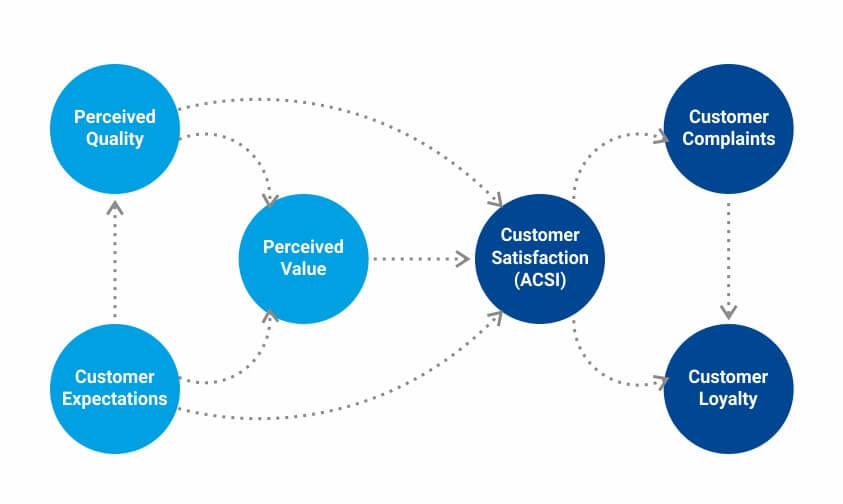
Watch the 1-minute tour
Founded by Dr. Claes Fornell in 1994, American Customer Satisfaction Index (ACSI) is an economic barometer that gauges cross-industry satisfaction levels amongst customers in the United States economy. Domestic and foreign goods with a substantial market share in the US will be judged on the customer satisfaction parameter by the American Customer Satisfaction Index (ACSI).
This national indicator benefits commercial organizations, researchers and statisticians, policy-creators, and customers equally by producing the vigor of customer satisfaction, measuring the competition amongst various customer-oriented organizations and forecasting the future avenues to improve customer satisfaction.
American Customer Satisfaction Index (ACSI) surveys around 180,000 customers to understand their satisfaction levels considering the products and services they frequently use.
American Customer Satisfaction Index (ACSI) is the single, most affluent national cross-operational computation of customer satisfaction across the United States. This index is decided by keeping various factors such as customer feedback for the standard of products and services bought in the U.S and manufactured by national or overseas organizations with a significant market share in the U.S.
American Customer Satisfaction Index (ACSI) was formed by the researchers at National Quality Research Center (NQRC) in association with the American Society for Quality in Milwaukee, Wisconsin, to calculate the satisfaction levels among customers for the products and services they have access to. Previously, no measurement tool could calculate the quality of products analyzed by keeping customers in mind.
It’s a model extracted from a Swedish Customer Satisfaction Barometer (SCSB) developed and executed in 1984. American Customer Satisfaction Index (ACSI) founder, Claes Fornell, created this model for both the Swedish and American customers. Due to this incredible derivation by Claes, he is considered as one of the most renowned scholars in marketing. Initially, American Customer Satisfaction Index (ACSI) updates were launched every quarter. Since 2010, it is updated more frequently for the public so that key contributors can channelize their work towards various sectors across the year with the change in the American Customer Satisfaction Index (ACSI).
Considering the facts and figures from 10 economic sectors and 44 industries, the national American Customer Satisfaction Index (ACSI) score has always been updated quarterly to date, revealing the vigor of the US economy. In simple terms, ACSI is a sum of customer satisfaction across various organizations with a considerable market share in the present economy. Their business revenue is extremely high, and the demand for their products and services across the US.
This national customer satisfaction level indicator is reliant on 3 critical 10 point scale questions to obtain customer satisfaction. These American Customer Satisfaction Index (ACSI) questions are categorized into: Satisfaction, Expectation Levels, and Performance.
Here’s a formula to normalize the results achieved from these three questions:
(Satisfaction + Expectancy + Performance - 3) / 27 * 100
A score between 0 - 100 is created using this formula, which can then be compared to the industrial standards published by the American Customer Satisfaction Index (ACSI). Ideally, all three parameters have different weights according to their industry as well as the state. It influences the American Customer Satisfaction Index (ACSI) customer satisfaction score calculation. This calculation is an average calculated by considering different weights for each of these parameters and also industrial standards.
If you’re interested in getting a precise American Customer Satisfaction Index (ACSI) customer satisfaction scores, you must commission a custom American Customer Satisfaction Index (ACSI) research program. In case you have a budget constraint, you can always do it yourself by calculating the index and deriving the benchmark.
The image above is the survey and modeling technique which clearly suggests that the arrows indicate influence, i.e., the factors that drive customer satisfaction can directly control customer loyalty.
- American Customer Satisfaction Index (ACSI) is an index based on three different values: Customer expectations, perceived quality, and perceived value. These parameters consider different aspects of customer satisfaction. The weight for each of these factors is calculated using a proprietary technology.
- Customer expectations evaluate what the customer considered the product or service to be and what did they actually experience. These expectations can be formed either from word-of-mouth or prior market research or belief in an organization’s previously proven reputation.
- Perceived quality is a parameter that evaluates customer experience in the recent past. It depends on how competitive the market is and whether the customer has experienced the competitor products or services and also on the frequency of usage.
- Perceived value is the standard of product or service in comparison to cost paid by the customers. Value, generally, impacts the first purchase but over a period of time becomes less impactful when it comes to building and maintaining customer satisfaction.
- Customer complaints are those customers who feel there’s a huge gap between what they were promised and what they were delivered. This gap can lead to displeasure which is key to customer satisfaction as higher displeasure indicate lower customer satisfaction levels.
- Customer loyalty is decided on the basis of likeliness of a customer repurchasing from the same organization and irrespective of cost linked to various products and services offered by this organization.
Established two decades ago, American Customer Satisfaction Index (ACSI) produces multiple inferences for all organizations as well the performance of U.S economy.
- First and foremost, customer satisfaction is integral in deciding the fate of an organization. Organizations with high American Customer Satisfaction Index (ACSI) scores have a high demand in the market along with better-performing stocks.
- American Customer Satisfaction Index (ACSI) score establishes whether members of a household will make a purchase of the particular brand or not. Any reported ups and downs reported in American Customer Satisfaction Index (ACSI) will play a vital role in this decision making.
- 70% of Gross Domestic Product (GDP) in the U.S is reliant on customers’ will to spend. Clearly, any growth in GDP is directly associated with customer satisfaction which is evaluated with American Customer Satisfaction Index (ACSI).
As it’s well-known GDP is a prime indicator of the economy and American Customer Satisfaction Index (ACSI) is an indicator of quality, any effect on American Customer Satisfaction Index (ACSI) will directly affect GDP. Not just the quantity but also the quality of the produced goods and services will thus, matter.
- Using results produced using American Customer Satisfaction Index (ACSI) over the years, it’s safe to state that manufactured goods or products have higher American Customer Satisfaction Index (ACSI) score in comparison to services.
That is, if customers require more service for a particular job, chances are that that particular job will have a low American Customer Satisfaction Index (ACSI) score. Commodities such as food items or electronic goods or other artifacts will have a higher American Customer Satisfaction Index (ACSI) in comparison to services such as hotels and restaurants, services for electronic goods etc.
- Across all the industries where American Customer Satisfaction Index (ACSI) is calculated, quality is superior to cost. In these industries, cost-cutting to market and sell a product is never effective and any promotional activities done keeping cost in mind will fail almost always.
Organizations across all industries that focus on being better at the quality of products and services exceed those who focus on being cost-effective.
Survey Software Easy to use and accessible for everyone. Design, send and analyze online surveys.
Research Suite A suite of enterprise-grade research tools for market research professionals.
Customer Experience Experiences change the world. Deliver the best with our CX management software.
Employee Experience Create the best employee experience and act on real-time data from end to end.












